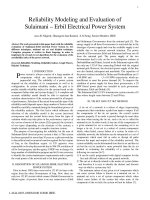Project financing evaluation
Bạn đang xem bản rút gọn của tài liệu. Xem và tải ngay bản đầy đủ của tài liệu tại đây (1.06 MB, 116 trang )
1.040/1.401
Project Management
Spring 2007
Project Financing & Evaluation
Dr. SangHyun Lee
Department of Civil and Environmental Engineering
Massachusetts Institute of Technology
Preliminaries
STELLAR access: to be announced
AS1 Survey due by tonight 12 pm
TP1 and AS2 are out
AS 2: Student Presentation
10 minute presentation followed by 5 minute discussion
1 or 2 presentations from Feb. 20 to Mar. 19
Topics
Your past project experience (strongly recommended if you have any)
Size of project is not important!
Project main figures
Main managerial aspects
Project management practices
Problems, strengths, weaknesses, risks
Your learning
Emerging construction technologies (e.g., 4D CAD, Virtual Reality, Sensing, …)
Volunteers for next week?
Preliminaries
STELLAR access: to be announced
AS1 Survey due by tonight 12 pm
TP1 and AS2 are out
Pictures will be taken before you leave
Who we are
Don’t memorize course content. Understand it.
Outline
Session Objective & Context
Project Financing
Financial Evaluation
Owner
Project
Contractor
Additional Issues
Time value of money
Present value
Rates
Interest Formulas
NPV
IRR & payback period
Missing factors
Session Objective
The role of project financing
Mechanisms for project financing
Measures of project profitability
Project Management Phase
FEASIBILITY
DESIGN
PLANNING
DEVELOPMENT
Financing & Evaluation
Risk
CLOSEOUT
OPERATIONS
Context: Feasibility Phases
Project Concept
Land Purchase & Sale Review
Evaluation (scope, size, etc.)
Constraint survey
Site constraints
Cost models
Site infrastructural issues
Permit requirements
Summary Report
Decision to proceed
Regulatory process (obtain permits, etc)
Design Phase
Lecture 2 - References
More details on:
Hendrickson PM for Construction on-line textbook
Chapter 7
Outline
Session Objective & Context
Project Financing
Financial Evaluation
Owner
Project
Contractor
Additional Issues
Time value of money
Present value
Rates
Interest Formulas
NPV
IRR & payback period
Missing factors
Financing – Gross Cashflows
years
OWNER
investment
operation incomes
owner cashflow
owner cum cashflow
1
2
3
4
5
6
7
8
9
10
($10,000,000) ($20,000,000)
$2,000,000
$4,000,000
$6,000,000
$6,000,000
$0 ($10,000,000) ($20,000,000) $2,000,000
$4,000,000
$6,000,000
$6,000,000
$0 ($10,000,000) ($30,000,000) ($28,000,000) ($24,000,000) ($18,000,000) ($12,000,000)
CONTRACTOR
costs
($4,000,000) ($7,000,000) ($14,000,000)
revenues
$0 $10,000,000 $20,000,000
contractor cashflow
($4,000,000) $3,000,000
$6,000,000
contractor cum cashflow
($4,000,000) ($1,000,000) $5,000,000
Owner investment = contractor revenue
$0
$0
$0
$5,000,000
$0
$0
$0
$5,000,000
$0
$0
$0
$5,000,000
$0
$0
$0
$5,000,000
$6,000,000
$6,000,000
($6,000,000)
$6,000,000
$6,000,000
$0
$6,000,000
$6,000,000
$6,000,000
$0
$0
$0
$5,000,000
$0
$0
$0
$5,000,000
$0
$0
$0
$5,000,000
Financing – Gross Cashflows
Design/Preliminary
years
OWNER
investment
operation incomes
owner cashflow
owner cum cashflow
1
Construction
2
3
4
5
6
7
8
9
10
($10,000,000) ($20,000,000)
$2,000,000
$4,000,000
$6,000,000
$6,000,000
$0 ($10,000,000) ($20,000,000) $2,000,000
$4,000,000
$6,000,000
$6,000,000
$0 ($10,000,000) ($30,000,000) ($28,000,000) ($24,000,000) ($18,000,000) ($12,000,000)
CONTRACTOR
costs
($4,000,000) ($7,000,000) ($14,000,000)
revenues
$0 $10,000,000 $20,000,000
contractor cashflow
($4,000,000) $3,000,000
$6,000,000
contractor cum cashflow
($4,000,000) ($1,000,000) $5,000,000
Owner investment = contractor revenue
$0
$0
$0
$5,000,000
$0
$0
$0
$5,000,000
$0
$0
$0
$5,000,000
$0
$0
$0
$5,000,000
$6,000,000
$6,000,000
($6,000,000)
$6,000,000
$6,000,000
$0
$6,000,000
$6,000,000
$6,000,000
$0
$0
$0
$5,000,000
$0
$0
$0
$5,000,000
$0
$0
$0
$5,000,000
Financing – Gross Cashflows
Design/Preliminary
years
OWNER
investment
operation incomes
owner cashflow
owner cum cashflow
1
Construction
2
3
4
5
6
7
8
9
10
($10,000,000) ($20,000,000)
$2,000,000
$4,000,000
$6,000,000
$6,000,000
$0 ($10,000,000) ($20,000,000) $2,000,000
$4,000,000
$6,000,000
$6,000,000
$0 ($10,000,000) ($30,000,000) ($28,000,000) ($24,000,000) ($18,000,000) ($12,000,000)
CONTRACTOR
costs
($4,000,000) ($7,000,000) ($14,000,000)
revenues
$0 $10,000,000 $20,000,000
contractor cashflow
($4,000,000) $3,000,000
$6,000,000
contractor cum cashflow
($4,000,000) ($1,000,000) $5,000,000
$0
$0
$0
$5,000,000
$0
$0
$0
$5,000,000
$0
$0
$0
$5,000,000
$0
$0
$0
$5,000,000
$6,000,000
$6,000,000
($6,000,000)
$6,000,000
$6,000,000
$0
$6,000,000
$6,000,000
$6,000,000
$0
$0
$0
$5,000,000
$0
$0
$0
$5,000,000
$0
$0
$0
$5,000,000
Owner investment = contractor revenue
• Early expenditure
• Takes time to get revenue
Project Financing
Aims to bridge this gap in the most beneficial way!
Critical Role of Financing
Makes projects possible
Has major impact on
Riskiness of construction
Claims
Prices offered by contractors (e.g., high bid price for late
payment)
Difficulty of Financing is a major driver towards alternate delivery
methods (e.g., Build-Operate-Transfer)
How Does Owner Finance a Project?
Public
Private
“Project” financing
Outline
Session Objective & Context
Project Financing
Financial Evaluation
Owner
Project
Contractor
Additional Issues
Time value of money
Present value
Rates
Interest Formulas
NPV
IRR & payback period
Missing factors
Public Financing
Sources of funds
Social benefits important justification
Benefits to region, quality of life, unemployment relief, etc.
Important consideration: exemption from taxes
Public owners face restrictions (e.g. bonding caps)
General purpose or special-purpose bonds
Tax revenues
Capital grants subsidies
International subsidized loans
Major motivation for public/private partnerships
MARR (Minimum Attractive Rate of Return) much lower (e.g. 8-10%),
often standardized
Private Financing
Major mechanisms
Equity
Invest corporate equity and retained earnings
Offering equity shares
Must entice investors with sufficiently high rate of return
May be too limited to support the full investment
May be strategically wrong (e.g., source of money, ownership)
Debt
Stock Issuance (e.g. in capital markets)
Borrow money
Bonds
Because higher costs and risks, require higher returns
MARR varies per firm, often high (e.g. 20%)
Private Owners w/Collateral Facility
Distinct Financing Periods
Short-term construction loan
Bridge Debt
Long-term mortgage
Senior Debt
Risky (and hence expensive!)
Borrowed so owner can pay for construction (cost)
Typically facility is collateral
Pays for operations and Construction financing debts
Typically much lower interest
Loans often negotiated as a package
construction
w/o tangible
operation
w/ tangible
time
Outline
Session Objective & Context
Project Financing
Financial Evaluation
Owner
Project
Contractor
Additional Issues
Time value of money
Present value
Rates
Interest Formulas
NPV
IRR & payback period
Missing factors
“Project” Financing
Investment is paid back from the project profit rather than the general assets or
creditworthiness of the project owners
For larger projects due to fixed cost to establish
Investment in project through special purpose corporations
Often joint venture between several parties
Need capacity for independent operation
Benefits
Small projects not much benefit
Off balance sheet (liabilities do not belong to parent)
Limits risk
External investors: reduced agency cost (direct investment in project)
Drawback
Tensions among stakeholders
Outline
Session Objective & Context
Project Financing
Financial Evaluation
Owner
Project
Contractor
Additional Issues
Time value of money
Present value
Rates
Interest Formulas
NPV
IRR & payback period
Missing factors
Contractor Financing I
Payment schedule
Break out payments into components
Often some compromise between contractor and owner
Architect certifies progress
Agreed-upon payments
Advance payment
Periodic/monthly progress payment (itemized breakdown structure)
Milestone payments
retention on payments (usually, about 10%)
Often must cover deficit during construction
Can be many months before payment received
S-curve Work
Man-hours
months









